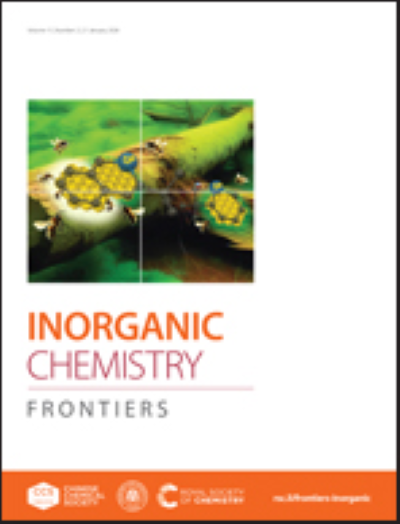Atomically precise Cu14 and Cu13 nanoclusters for oxygen evolution reaction: One additional Cu atom matters
IF 6.1
1区 化学
Q1 CHEMISTRY, INORGANIC & NUCLEAR
引用次数: 0
Abstract
Atomically precise coinage metal nanoclusters have been widely explored as model catalysts to study the structure-performance relationship, yet single atom addition onto the metal core to tailor the catalytic properties still remains challenging. Herein, we report a pair of atomically precise Cu nanoclusters, namely [Cu14(Fur)3(PPh3)8H10]+ and [Cu13(Nap)3(PPh3)7H10]0 (hereafter referred to as Cu14 and Cu13, Fur: 2-methyl-3-furanthiolate, Nap: 1-naphthalene thiolate), which exhibit an astonishingly high degree of structural similarity, differing merely by the addition of a single Cu atom yet possessing drastically different catalytic performance toward oxygen evolution reaction (OER). Specifically, in 1 M KOH solution, Cu14 has a much lower overpotential than Cu13 (306 mV vs. 382 mV) to afford a current density of 10 mA cm-2, a smaller Tafel slope and a lower charge transfer resistance. Density functional theory calculations were employed to further identify the catalytic acitve site, confirming that the additonal Cu atom in Cu14 is the key catalytic site which can significantly lower the energy barrier of the rate determining step in OER. This study highlights the crucial role of single-atom addition in modulating the properties and functionalties of atomically precise metal nanoclusters, shedding light on future catalyst design.原子精确的析氧反应Cu14和Cu13纳米团簇:一个额外的Cu原子很重要
原子精密铸造金属纳米团簇作为模型催化剂已被广泛探索以研究结构-性能关系,但在金属核上添加单原子来调整催化性能仍然是一个挑战。在此,我们报道了一对原子精确的Cu纳米团簇,即[Cu14(Fur)3(PPh3)8H10]+和[Cu13(Nap)3(PPh3)7H10]0(以下简称Cu14和Cu13, Fur: 2-甲基-3-呋喃硫酸酯,Nap: 1-萘硫酸酯),它们具有惊人的高度结构相似性,仅因添加单个Cu原子而不同,但对氧析出反应(OER)具有截然不同的催化性能。具体来说,在1 M KOH溶液中,Cu14的过电位比Cu13低得多(306 mV vs 382 mV),可以提供10 mA cm-2的电流密度,更小的Tafel斜率和更低的电荷转移电阻。利用密度泛函理论计算进一步确定了催化活性位点,证实了Cu14中额外的Cu原子是关键的催化位点,可以显著降低OER中速率决定步骤的能垒。这项研究强调了单原子添加在调节原子精确金属纳米团簇的性质和功能方面的关键作用,为未来的催化剂设计提供了启示。
本文章由计算机程序翻译,如有差异,请以英文原文为准。
求助全文
约1分钟内获得全文
求助全文
来源期刊

Inorganic Chemistry Frontiers
CHEMISTRY, INORGANIC & NUCLEAR-
CiteScore
10.40
自引率
7.10%
发文量
587
审稿时长
1.2 months
期刊介绍:
The international, high quality journal for interdisciplinary research between inorganic chemistry and related subjects
 求助内容:
求助内容: 应助结果提醒方式:
应助结果提醒方式:


